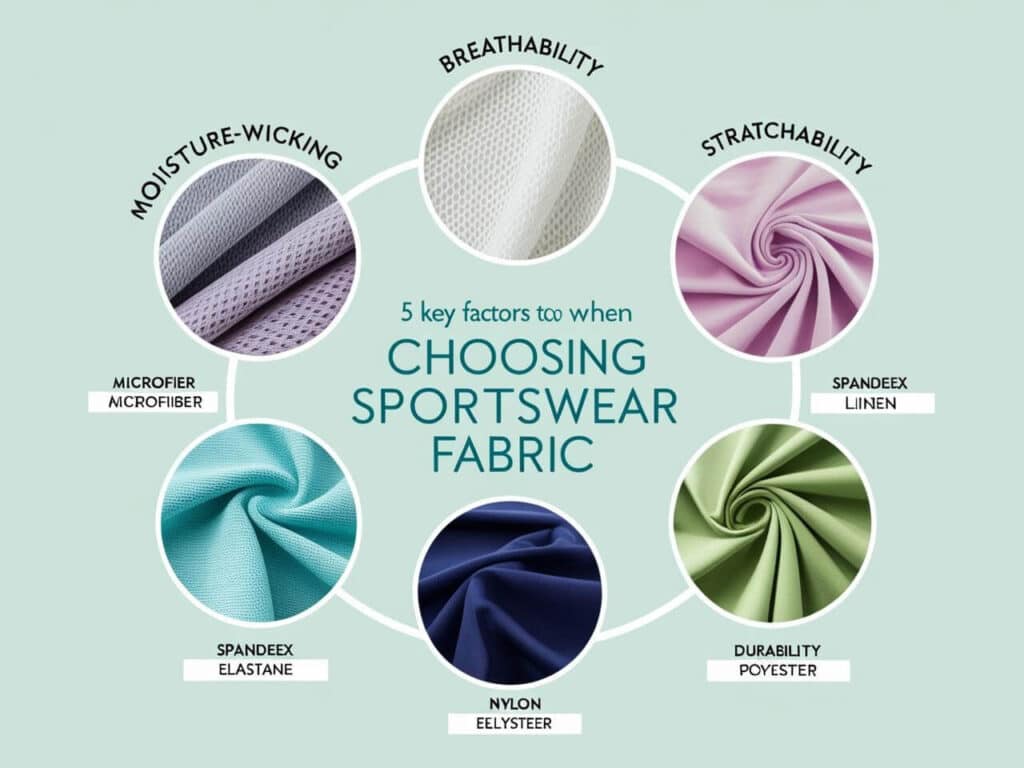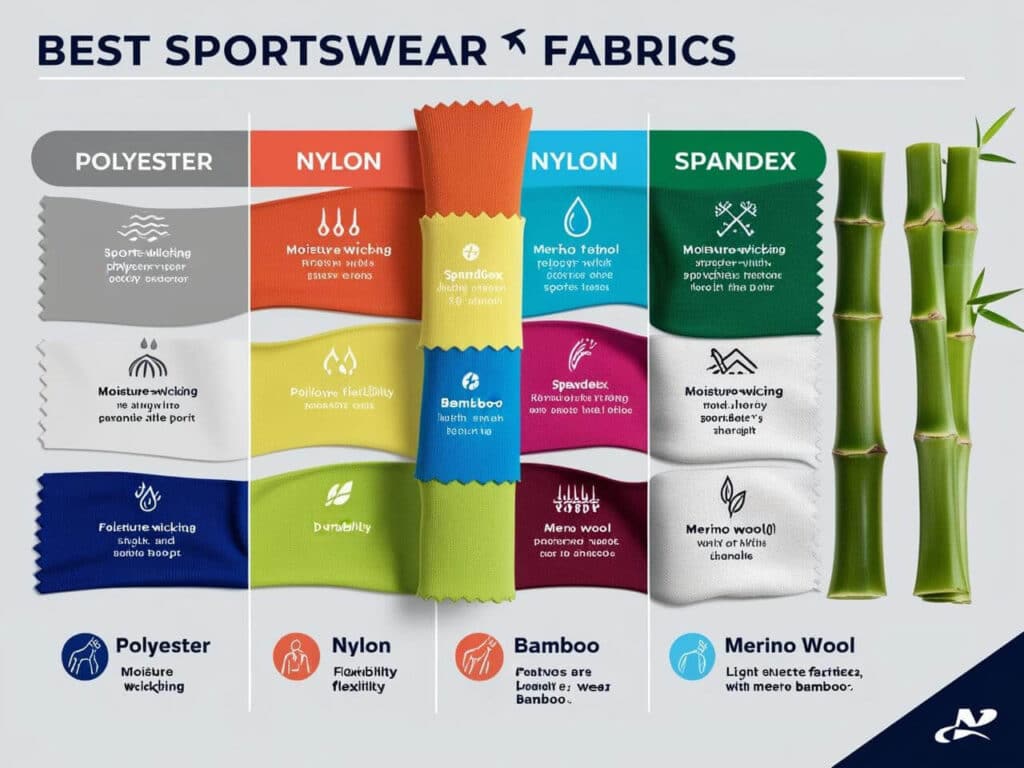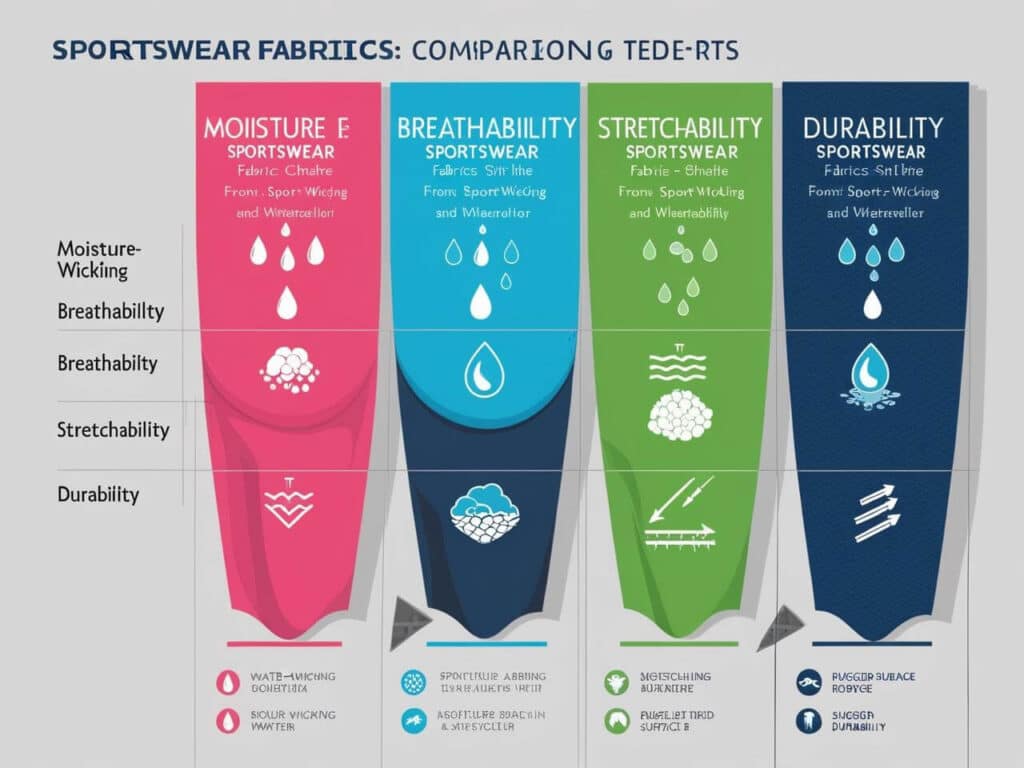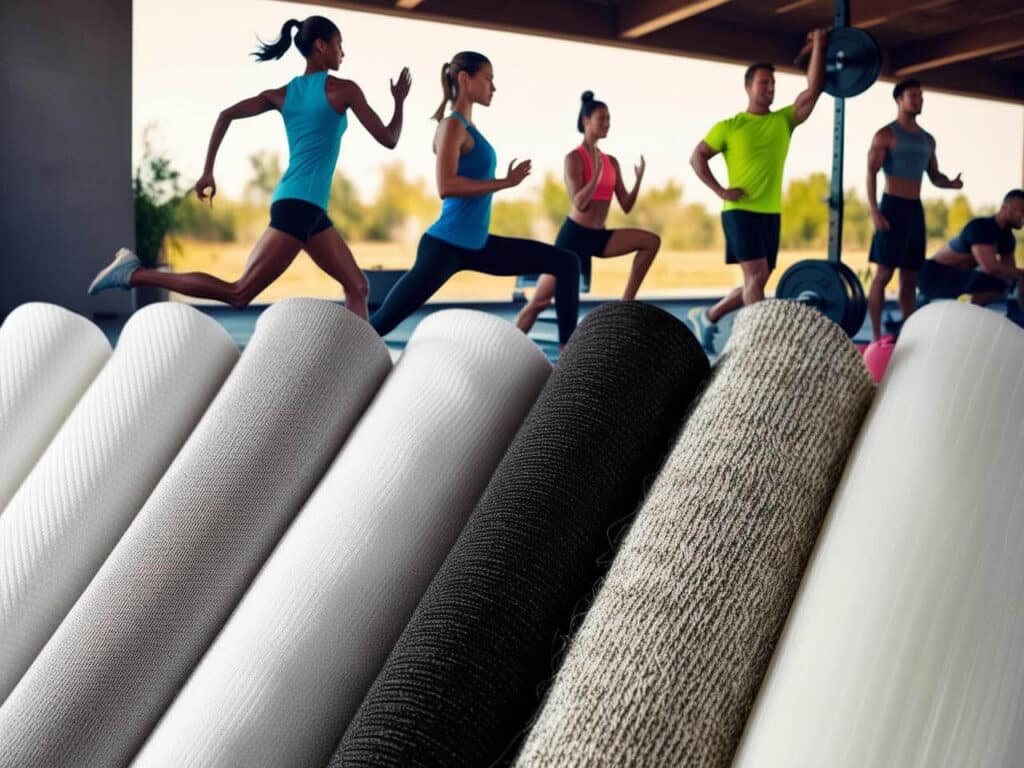Introduction
The fabric you choose for sportswear directly impacts performance, comfort, and durability. Whether you’re running, lifting weights, or practicing yoga, the right material can help wick away sweat, improve flexibility, and withstand frequent wear.
I’ve tested and researched multiple sportswear fabrics, and I’ve found that some materials excel at moisture-wicking, while others provide better flexibility and breathability. But how do you know which one is best for you?
In this guide, you’ll discover:
✔ The top fabrics for sportswear and their key benefits.
✔ How different materials perform for various sports and activities.
✔ Eco-friendly alternatives like bamboo and recycled polyester.
Let’s find the perfect fabric for your workout needs!
Key Factors to Consider When Choosing Sportswear Fabric

Choosing the right sportswear fabric affects performance, comfort, and durability. Here are the key factors to consider:
1️⃣ Moisture-Wicking Ability 💦
✔ Why it matters: Sweat can make clothing heavy and uncomfortable, reducing performance.
✔ Best fabrics: Polyester, bamboo, and merino wool effectively wick away sweat.
✔ Worst fabrics: Cotton absorbs moisture and dries slowly, making it less ideal for intense workouts.
2️⃣ Breathability 🌬
✔ Why it matters: Breathable fabrics allow airflow and prevent overheating.
✔ Best fabrics: Bamboo, nylon, and polyester blends improve ventilation.
✔ Worst fabrics: Thick synthetic blends without mesh panels can trap heat.
3️⃣ Stretch & Flexibility 🤸♂️
✔ Why it matters: Sportswear should move with your body, allowing free movement.
✔ Best fabrics: Spandex (Lycra) blended with polyester or nylon for a 4-way stretch effect.
✔ Worst fabrics: Rigid materials limit flexibility, reducing comfort in high-mobility sports.
4️⃣ Durability & Shape Retention 🔥
✔ Why it matters: Sportswear should maintain its structure and elasticity after multiple washes.
✔ Best fabrics: Polyester and nylon blends are highly durable and resist wear.
✔ Worst fabrics: Pure cotton loses shape over time and is prone to shrinking.
5️⃣ Sustainability & Eco-Friendly Choices 🌱
✔ Why it matters: Sustainable materials reduce environmental impact while offering performance benefits.
✔ Best fabrics: Bamboo, organic cotton, and recycled polyester (Repreve®) are eco-conscious choices.
✔ Worst fabrics: Traditional polyester and synthetic fabrics rely on petroleum-based production.
Best Fabrics for Sportswear (Pros & Cons)

Different sportswear fabrics offer varying levels of comfort, durability, and performance. Here’s a breakdown of the best materials for activewear and their advantages.
1️⃣ Polyester – The Performance Standard
✔ Sweat-wicking & quick-drying – Keeps you dry during intense workouts.
✔ Highly durable & wrinkle-resistant – Lasts through frequent washing.
✔ Often blended with spandex for added stretch – Improves flexibility.
🔻 Can retain odors over time – Requires anti-microbial treatment for odor control.
📌 Best for: Running, gym workouts, and high-performance sportswear.
2️⃣ Nylon – Soft, Lightweight & Flexible
✔ Soft & breathable – Comfortable for all-day wear.
✔ Excellent stretch & flexibility – Moves with your body.
✔ Quick-drying and moisture-wicking – Suitable for high-intensity workouts.
🔻 Less resistant to abrasion compared to polyester – May wear out faster.
📌 Best for: Compression wear, fitted sportswear, and yoga leggings.
3️⃣ Spandex (Lycra/Elastane) – Maximum Flexibility
✔ 4-way stretch provides unrestricted movement – Ideal for dynamic exercises.
✔ Enhances comfort when blended with polyester or nylon.
✔ Retains shape after multiple washes – Prevents sagging.
🔻 Not moisture-wicking on its own – Needs a polyester or nylon blend.
📌 Best for: Yoga, HIIT workouts, and flexible activewear.
4️⃣ Bamboo Fabric – The Eco-Friendly Alternative
✔ Naturally moisture-wicking and antibacterial – Prevents odor buildup.
✔ Soft and breathable – Comfortable for long wear.
✔ Sustainable & biodegradable – Reduces environmental impact.
🔻 Less durable than synthetic fabrics – Can stretch out over time.
📌 Best for: Eco-conscious sportswear & casual athletic wear.
5️⃣ Merino Wool – Best for Temperature Control
✔ Regulates body temperature in both hot and cold conditions.
✔ Naturally sweat-resistant & odor-resistant.
✔ Soft and comfortable for extended wear.
🔻 More expensive than synthetic sportswear fabrics.
📌 Best for: Outdoor sports, hiking, and cold-weather workouts.
🔗 External Resource:
Sportswear Fabric Comparison Table

To help you compare different sportswear fabrics, here’s a detailed breakdown of their performance factors.
| Fabric | Moisture-Wicking | Breathability | Stretchability | Durability | Best For |
| Polyester | ✅ High | ⚠️ Medium | ✅ High | ✅✅ Excellent | General workouts, running, gym wear |
| Nylon | ✅ High | ✅ High | ✅ High | ✅ High | Compression wear, fitted sportswear |
| Spandex | ⚠️ Low | ✅ High | ✅✅ Maximum | ✅ High | Yoga, flexibility workouts, HIIT |
| Bamboo | ✅ High | ✅✅ Excellent | ✅ High | ⚠️ Medium | Eco-friendly sportswear, casual wear |
| Merino Wool | ✅✅ Excellent | ✅ High | ⚠️ Medium | ✅ High | Outdoor workouts, cold-weather sports |
🔗 External Resource:
FAQs (People Also Ask)
Here are answers to some of the most frequently asked questions about sportswear fabrics, based on Google’s “People Also Ask” section.
❓ What is the best fabric for sportswear?
✔ Polyester and nylon are the most common choices for their moisture-wicking, durability, and breathability.
❓ Is cotton good for sportswear?
✔ No, cotton absorbs sweat and stays wet, making it uncomfortable for intense workouts.
❓ What is the most breathable sportswear fabric?
✔ Bamboo and merino wool offer natural breathability, while polyester blends are engineered for airflow.
❓ What fabric is best for gym clothes?
✔ Polyester or spandex-blended materials provide stretch and sweat resistance.
❓ What is the best eco-friendly sportswear fabric?
✔ Bamboo and recycled polyester are the top choices for sustainable activewear.
Choosing the Best Fabric for Your Sportswear
The right fabric for sportswear can enhance performance, comfort, and durability. Whether you’re hitting the gym, running outdoors, or practicing yoga, selecting the best material ensures flexibility, breathability, and sweat management.
✔ Key Takeaways:
- Polyester & Nylon – Best for sweat-wicking, durability, and general workouts.
- Spandex – Ideal for high-movement sports, offering maximum flexibility.
- Bamboo – A sustainable choice that’s breathable and antibacterial.
- Merino Wool – Great for temperature control in outdoor and cold-weather training.
✔ Final Tips:
- For high-intensity workouts, choose moisture-wicking polyester blends.
- If flexibility is a priority, opt for spandex-infused fabrics.
- For an eco-friendly alternative, look for bamboo or recycled polyester sportswear.
Final Thoughts
By understanding the strengths and weaknesses of each fabric, you can select the best sportswear for your fitness needs. Investing in high-quality performance fabrics ensures long-lasting comfort and functionality.
